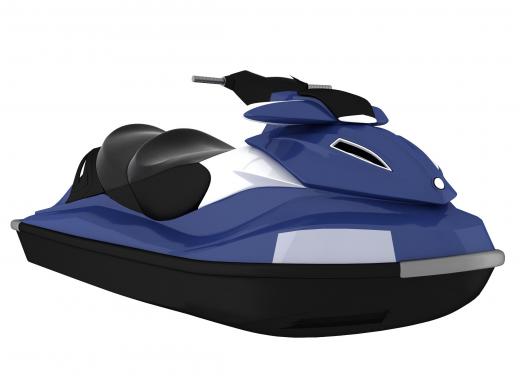At Sports&Hobbies, we're committed to delivering accurate, trustworthy information. Our expert-authored content is rigorously fact-checked and sourced from credible authorities. Discover how we uphold the highest standards in providing you with reliable knowledge.
What is Wakeboarding?
Wakeboarding is an extreme watersport that combines techniques from surfing, waterskiing and snowboarding. A wakeboard is typically towed behind a boat or personal watercraft, features slender bottom fins, fixed boot-style bindings, and is ridden sideways like a snowboard or skateboard.
Wakeboards are designed to skim over the surface of the water, jump wakes, and reverse so that the rider can ride it backward (called “a fakie”). Experienced riders can also “get air” or leave the water by shooting over the wake to flip the board tail-over-tip, or roll it toes-over-heels.

Wakeboarding evolved out of several sports but fundamentally grew from skurfing (waterskiing + surfing), a sport made popular in the 1980s wherein a boat pulls a rider on a surfboard. In 1984 Tony Finn of San Diego and partner John Hamilton started designing smaller boards for this sport and mass produced them through their company Skurfer, Incorporated.
While skurfing became very popular, it didn’t exactly catch fire. Skurfboards, thick and buoyant, were difficult for the average person to ride and the sport required significant skill and strength just to get the skurfboard planed.
Jimmy Redmond, an enthusiast from Austin Texas, decided skurfing would be more fun if skurfboards had bindings for greater control. In 1990 this innovation was followed by the fortuitous interest of the legendary Herb O’Brien, founder of several successful waterski companies. O’Brien teamed up with some Hawaiian surfboard designers to come up with the first real commercial wakeboard, the Hyperlite.
With production of the Hyperlite, wakeboarding became accessible to virtually everyone. The compression-molded board incorporated many special features that not only made it user-friendly for deep-water and dock starts, but highly maneuverable. Neutral-buoyant with a thin profile and sharp edges for carving into a wake, the Hyperlite set the standard for wakeboards to come. And come they did from major watersports manufacturers and entrepreneurs alike.
While the first wakeboards had narrow tips and tails somewhat resembling a surfboard, evolution of the sport resulted in blunter designs with “twin tails” and a fin at both ends. This design allowed the rider to maintain a centered stance and ride the board in the forward or fakie position with equal ease. Other innovations like channeled bottoms and improved bindings ensured wakeboarding would rapidly grow to become an international, competitive sport.
In 1990 Jimmy Redmon founded the World Wakeboard Association and by 1992 major sporting events organizers were staging professional wakeboard events. WakeBoarding Magazine was launched in 1993, and there are various competitions for both professionals and amateurs including the World Wakeboard Championships and the Hyperlite Amateur tournaments. In 1996 ESPN televised the X-Games showcasing wakeboarding.
Wakeboards are available wherever watersports equipment is sold. Wakeboards range in price starting at about $300 US Dollars (USD) and bindings are sold separate. Since wakeboarding also requires towing by boat or personal watercraft, it is considered an upscale sport as compared to surfing or snowboarding.
AS FEATURED ON:
AS FEATURED ON:











Discussion Comments
Jimmy Redmon did NOT mount bindings onto Skurfers. He made his own wakeboards with bindings starting in 1985.
The first "twin-tip" design was the Flight 69 created by Jimmy Redmon.
Post your comments